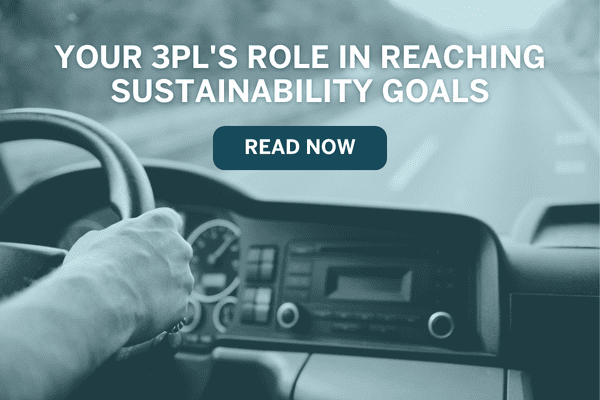Sustainability has become a critical focus for businesses aiming to reduce their environmental impact. Your third-party logistics (3PL) provider plays a vital role in this transition by offering expertise and resources that can help companies implement sustainable practices.
Organizing Your Distribution Network
Network Optimization
One of the primary ways a 3PL can enhance sustainability is through effective network optimization. By analyzing transportation routes and the ideal distribution hubs, a 3PL can identify opportunities to minimize fuel consumption and reduce greenhouse gas emissions.
Your 3PL’s advanced technologies with the support of machine learning and AI can find the best, lowest-fuel routes, taking into account the bulk of your delivery locations, rent costs, weather patterns, and more.
This not only lowers carbon footprints but also cuts transportation costs, creating a win-win scenario for businesses focused on sustainability.
Warehouse Optimization
Sustainable warehousing involves implementing eco-friendly practices that reduce energy consumption and waste.
For instance, your 3PL should recommend strategies that include:
- Energy-efficient lighting: Switching to LED lights can reduce energy costs by up to 20% while also lowering carbon emissions.
- Smart climate control systems: Utilizing advanced HVAC systems that adjust based on occupancy can further decrease energy use.
- Waste reduction programs: Implementing recycling initiatives and optimizing inventory management helps minimize waste and enhances resource efficiency.
Ask your 3PL for an analysis of adding these practices into your facility.
Analyzing Energy Sources
Renewable Energy
A significant aspect of sustainability is the transition to renewable energy sources. Your 3PL can guide you in adopting energy-efficient solutions such as solar panels for warehouse operations. These renewable energy sources reduce reliance on fossil fuels, leading to lower greenhouse gas emissions and decreased energy costs over time.
LED Lighting
Replacing traditional lighting with LED fixtures not only conserves energy but also has a longer lifespan, reducing waste associated with frequent replacements. LED lighting can reduce energy consumption by up to 75%, reducing your carbon footprint along the way.
Lithium-Ion Batteries
Your MHE is also driving energy consumption. Transitioning from lead-acid batteries to lithium-ion batteries for forklifts and other MHE offers substantial environmental benefits. Lithium-ion batteries are more efficient, have a longer lifespan (up to five times longer than lead-acid), and produce fewer emissions during their lifecycle. Although they may have a higher upfront cost, their longevity and reduced environmental impact make them a more sustainable choice in the long run.
By focusing on these energy sources, your 3PL can help you significantly lower your operational carbon footprint while also reducing costs.
Recommending the Right Automation and Robotics
Automation is transforming logistics operations, making them more efficient and sustainable. A 3PL can assist in integrating automated systems that optimize warehouse processes, thereby reducing energy consumption and enhancing productivity.
Automated Storage and Retrieval Systems (ASRS): These systems require less human intervention, which translates into lower energy usage for lighting and climate control in large warehouses.
Robotics for Repetitive Tasks: Utilizing robots for repetitive tasks allows human workers to focus on higher-value activities that contribute to sustainability initiatives. This shift not only improves efficiency but also enhances employee satisfaction by allowing them to engage in more meaningful work.
Data-Driven Decision Making: Moreover, automation provides valuable data insights that can drive sustainability efforts. A 3PL equipped with advanced analytics tools can monitor emissions, track energy usage, and assess overall operational efficiency. This data-driven approach enables businesses to identify areas for improvement continuously and adapt their strategies accordingly.
Your 3PL Partner in Sustainability
Partnering with a sustainable 3PL provider offers numerous advantages for companies looking to enhance their environmental responsibility while maintaining operational efficiency.
By focusing on network and warehouse optimization, transitioning to renewable energy sources like LED lighting and lithium-ion batteries, and leveraging automation technologies, businesses can significantly reduce their carbon footprint.
As sustainability becomes increasingly important in today’s market, working with a knowledgeable 3PL will not only help you meet regulatory requirements but also position your brand favorably among eco-conscious consumers. Embracing these practices will pave the way for a greener future for your business and contribute positively to the planet’s health.
How is Kenco driving sustainability? Read Kenco’s 2024 Sustainability Report

